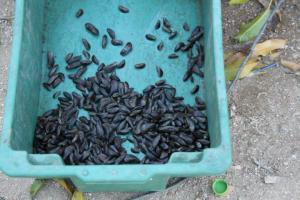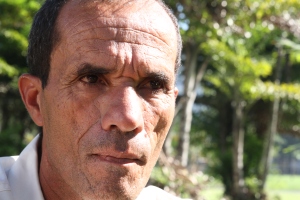The Last Fishermen of Sepetiba Bay
Western Rio is the location of Sepetiba Bay, whose ecosystem and surrounding areas make it one of the richest biodiversity hotspots in the world. In 1986, the beach region close to the bay was given protected status by Brazilian authorities. The area “Brisas” is also renowned for its diverse cultural heritage, including the trade of artisanal fishery kept alive until today by thousands of local families.
At Ilha da Madeira, one entry point into the Sepetiba Bay, the water is filled with small colourful boats, a few out on the water, many left abandoned, a couple up for sale in spite of their advanced state of  decay. Looking toward the horizon gives a hint of why some of the boats have been laid to rest: a huge, almost one-kilometre-long pier dominates the view, making it difficult for the small boats to pass through.
decay. Looking toward the horizon gives a hint of why some of the boats have been laid to rest: a huge, almost one-kilometre-long pier dominates the view, making it difficult for the small boats to pass through.
The Pier Problem
The pier is the most recent infrastructure project constructed to handle exports of steel and ore from Brazil to resource-hungry countries in Europe and Asia. In all, the bay now hosts five ports for international trade, the biggest of them serving the ThyssenKrupp Companhia Siderurgica do Atlantico (TKCSA), owned 73 percent by German steel giant ThyssenGrupp with the rest of the stakes held by Brazilian Vale.
In the greater Rio de Janeiro area, TKCSA operates a steel plant which began operations in 2010, as well as adjacent power and chemical plants and port infrastructure.
For the fishermen in Sepetiba Bay, the piers are the problem. And the main target for locals’ complaints is TKCSA: they operate the first and biggest pier constructed there, and the company’s steel plant has been repeatedly blamed for causing severe air pollution in western Rio.
“Before the company came here, we could bring home even 60 pounds of shrimp a day,” says fisherman Sergio de Souza-Rodriguez, as he drives his dilapidated boat out into the bay. “Now it is more like one pound per day.”Now, it has become too dangerous for fishermen to pass their boats through the openings in the piers.
High Unemployment
ThyssenKrupp CSA came to the bay with huge promises, offering everyone jobs and a steady income. Isac de Oliveira, President of the Sepetiba Bay Artisan Fishing Association claimed that in 2010 TKCSA promised to create 2,500 new jobs for local Brazilians. However according to Oliveira, ThyssenKrupp failed to deliver. Work was not only temporary, but a large portion of the workforce is made up of Brazilians from other parts of the country, with a heavy concentration from the north east. There were also rumors that the TKCSA was employing thousands of undocumented Chinese immigrants during the initial phase of construction. In the end, Oliveira claimed 8,000 fishermen lost their jobs because of ThyssenKrupp.
Jaci do Nascimento, one of the local fishermen activists that took part in the Toxic Tour during Rio+20, told IPS that before the advent of the plant, fishermen would take 200 boxes of 23 to 27 kg each in a day’s fishing. “Nowadays, after working ourselves to the bone for 16 hours, we barely catch 17 kg,” he said.
Pollution and Contamination
The fishermen also complain about the pollution being released into the bay by the industrial operations: digging underwater to construct the piers has disturbed toxic waste residues lying there following repeated spills from another industrial operation in the region, of Inga Mercantil. Cadmium poisoning, which is caused by steel plate runoff, is another toxic factor that is killing fish and harming locals health.
The fishermen do not want to accept their fate, that the industrial industry has ruined their livelihoods. Ivo Siquera Soares, one of the fishermen leaders, laughs, saying, “We will not sit and watch this boat pass” – rebelliously reverting a Portuguese phrase that signals powerlessness (estamos vendo a barca passar). Siquera Soares calls for a change of system and for the nexus between politicians and big capital to be broken. Source: TerraViva
Security
Due to the high volume of threats local fishermen are receiving from militias, “The Sacrifice Zone” has decided to keep most of the fishermen’s names anonymous. Local militias have made it hard to speak out against the ThyssenKrupp corporation so many have been forced to live silent and oppressed. In another environmental justice issue with Petrobras, fishermen from the same area have been tortured and one was murdered. According to IPS, Marcel Freixo a Brazilian lawmaker who has fervently been fighting militias, told IPS that threats against residents involved in the protests against TKCSA were a matter of concern. One victim of such threats is currently in the justice system’s witness protection program. Freixo also attributed the threats to “militias” — armed groups including former police officers that run illegal businesses in Rio de Janeiro and other states.“Michele” (not the source’s real name, for security reasons) told IPS that the militias have a hand in controlling hiring at the plant. Source: IPS
Isac de Oliveira, is the President of the Association of Fisherpeople of Pedra de Guaratiba (Associação de Pescadores e Aquicultores de Pedra de Guaratiba) has been a fisherman since he was 8 years old. He, along with several other brave fishermen, refuse to be silenced and have spoken out about what is really going on in the bay.
The Sacrifice Zone Project’s goal is to empower more people like De Oliveira, to advocate for environmental justice and equity.

